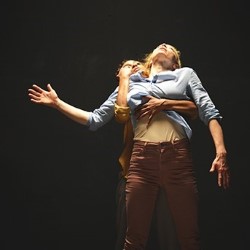WRoNGHEADED opens with beautiful images: Mary Wycherley’s film of natural landscape – iceberg, water – glides into our vision before we see any dancers (it has featured in dance film festivals around the world and won an award in Kerry in 2017). Set to Elaine Feeney’s fierce poetry, the environment is swirly and sleepy in atmosphere. An elegiac lace-clad wood nymph drifts, contrasting with the glistening, jaggedy rockface; it’s a near-monochrome palette.
A single dancer slides on from a downstage corner, back arching, arm curving over, quiet as if on snow, not disturbing, not attracting attention. Electronic music now. We recognise the woman from the film become concrete, in the breath and shadow. There is an air of seriousness.
Liz Roche Company are currently in residence at the Dublin Festival and Roche herself is an experienced choreographer. Created in 2016, it sought to “highlight the frustration that many women feel in relation to the choices that have been available to them around their bodies in Ireland”, so it is indeed serious. Happily, some monumental changes have taken place since then, but there is still a way to go obviously.
For a time, the two women share the space but do not touch. With shoulders hunched, they slip and slide in slow motion, they roll, explore, suspend. One reaches with her chest. A breast is almost touched. Later hands are thrust between thighs; fingers are splayed; sudden sinewy ripples rack the torso and there’s an abrupt change of direction. Then it starts to change: angled arms, a knee crossed over a taut leg and they join. In a Contact Improvisation-based duet, any spaces between the dancers is highly charged. They react off each other, brush against, spring away from, only to return to the crook of a knee or armpit. After a struggle one lands on top of the other, a dead weight, and it takes some wriggling for the other to extricate herself.
The poem is complex, and only snippets come through when the focus is on the action: “Sorry, sorry”, “I’m in debt to you for giving me air to live”, “Nonononono”. Attention is necessarily split between the movement language and the words. The choreographer has mined the poem for ideas, so is it necessary to use it in its entirety? Its quality and that of the steps are imbalanced: one thought provoking and direct; the other sensual and atmospheric, dreamlike. Ultimately this is the type of contemporary dance which is dense and speaks to the initiated. It is not easily accessible, but aficionados will be impressed.
